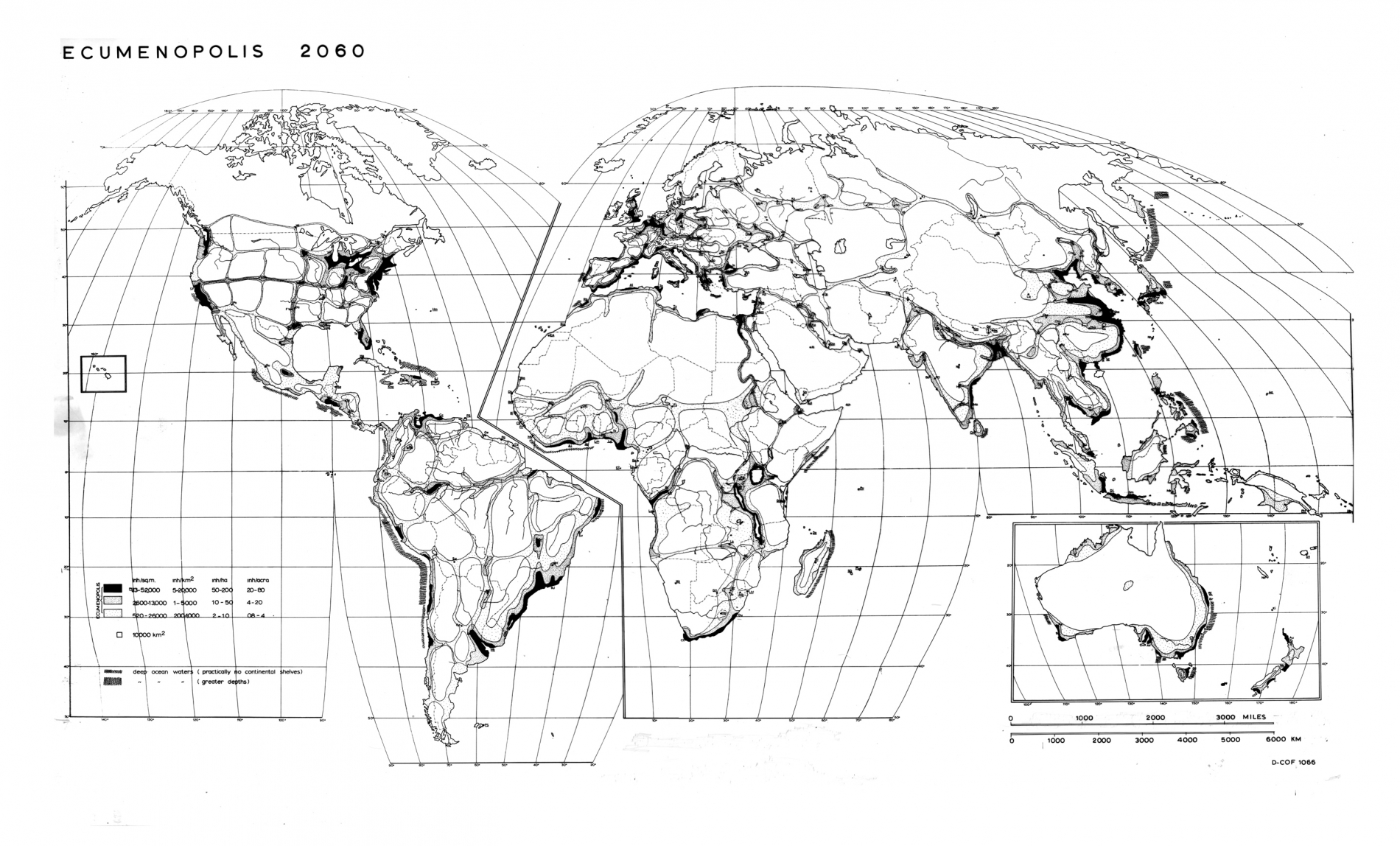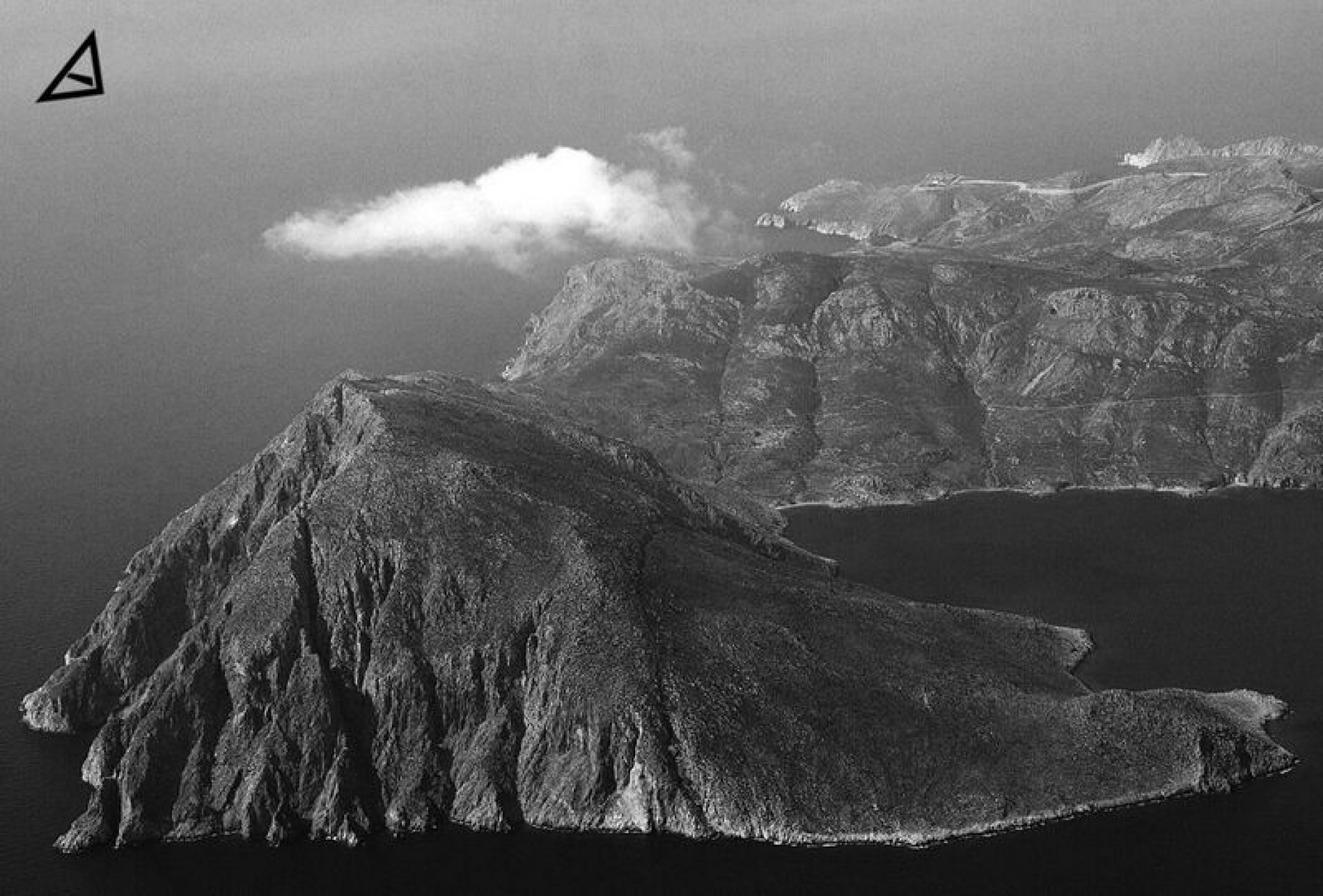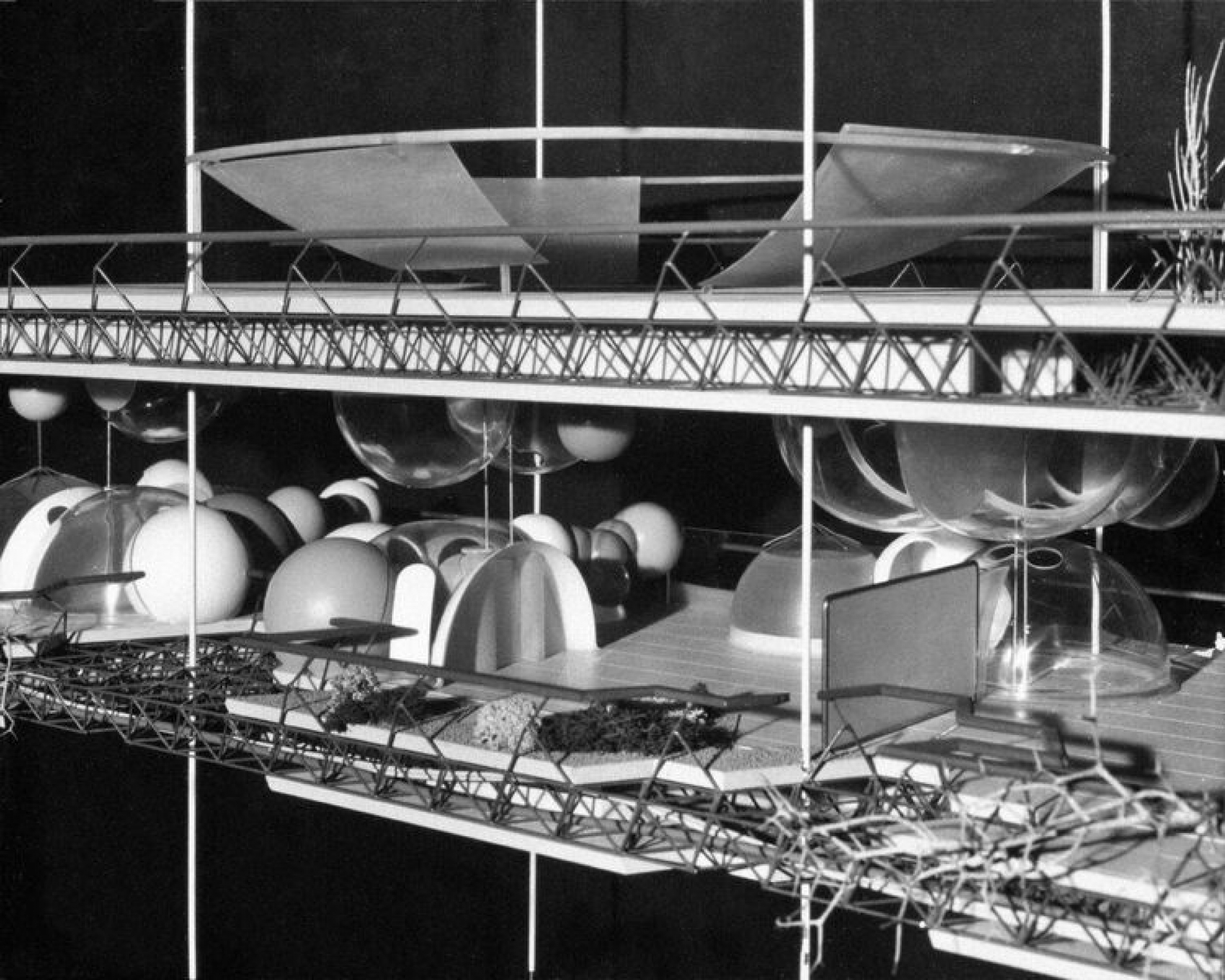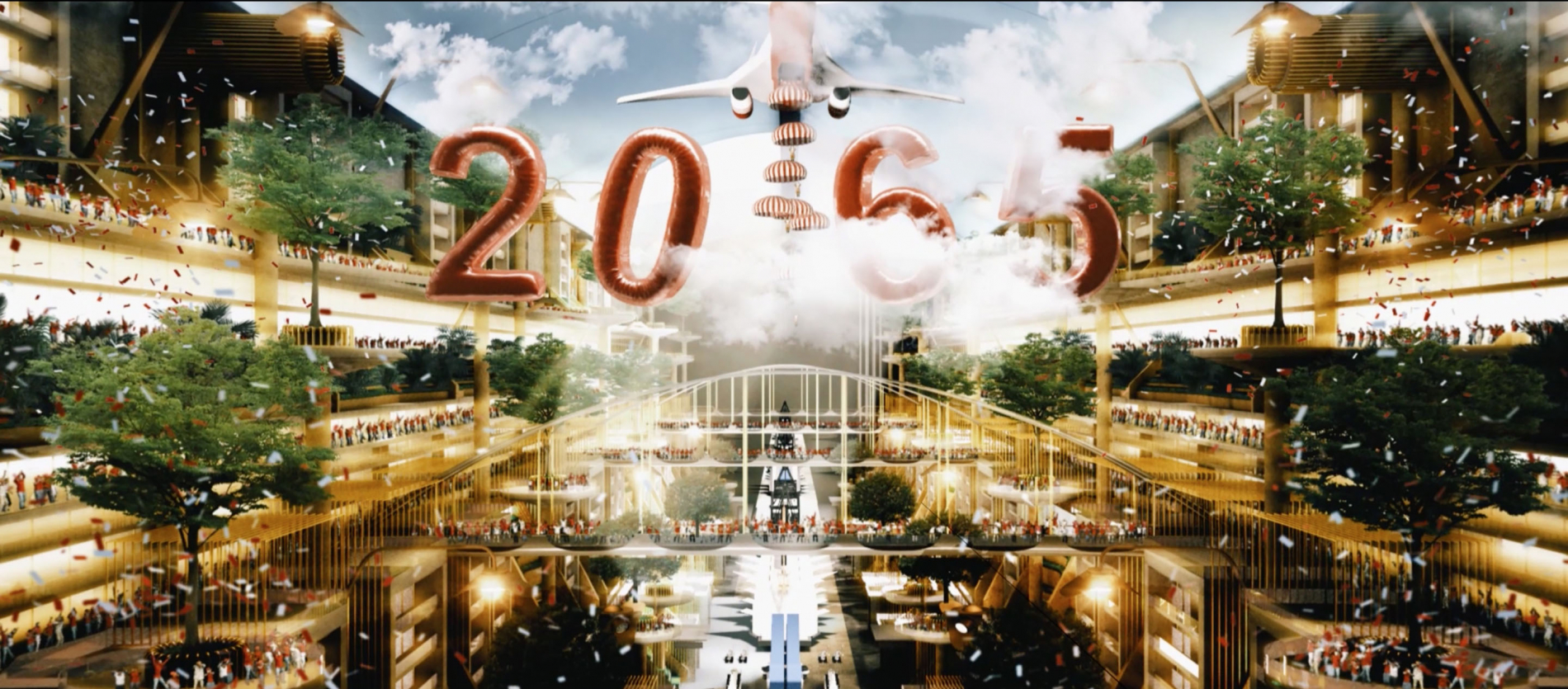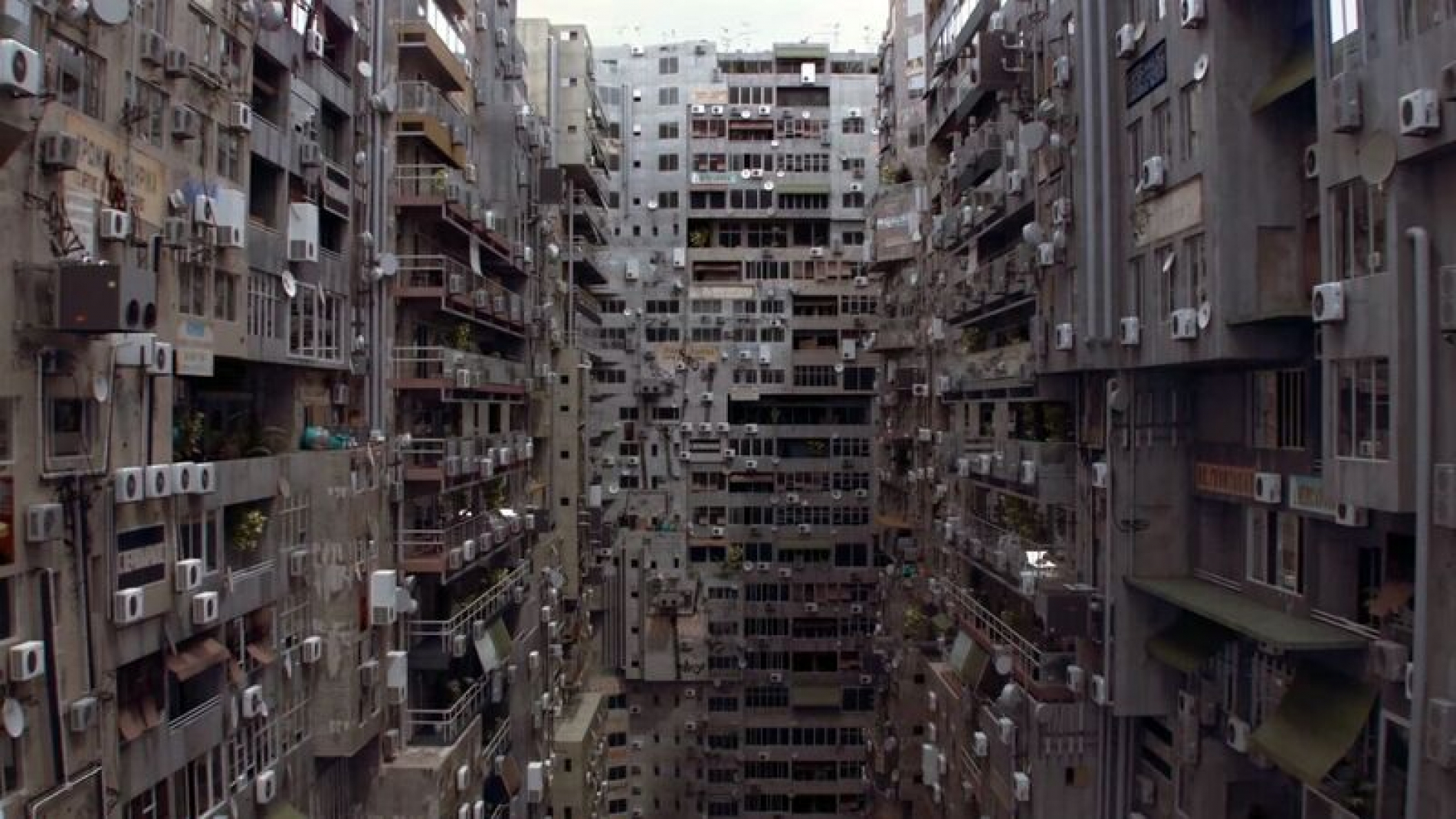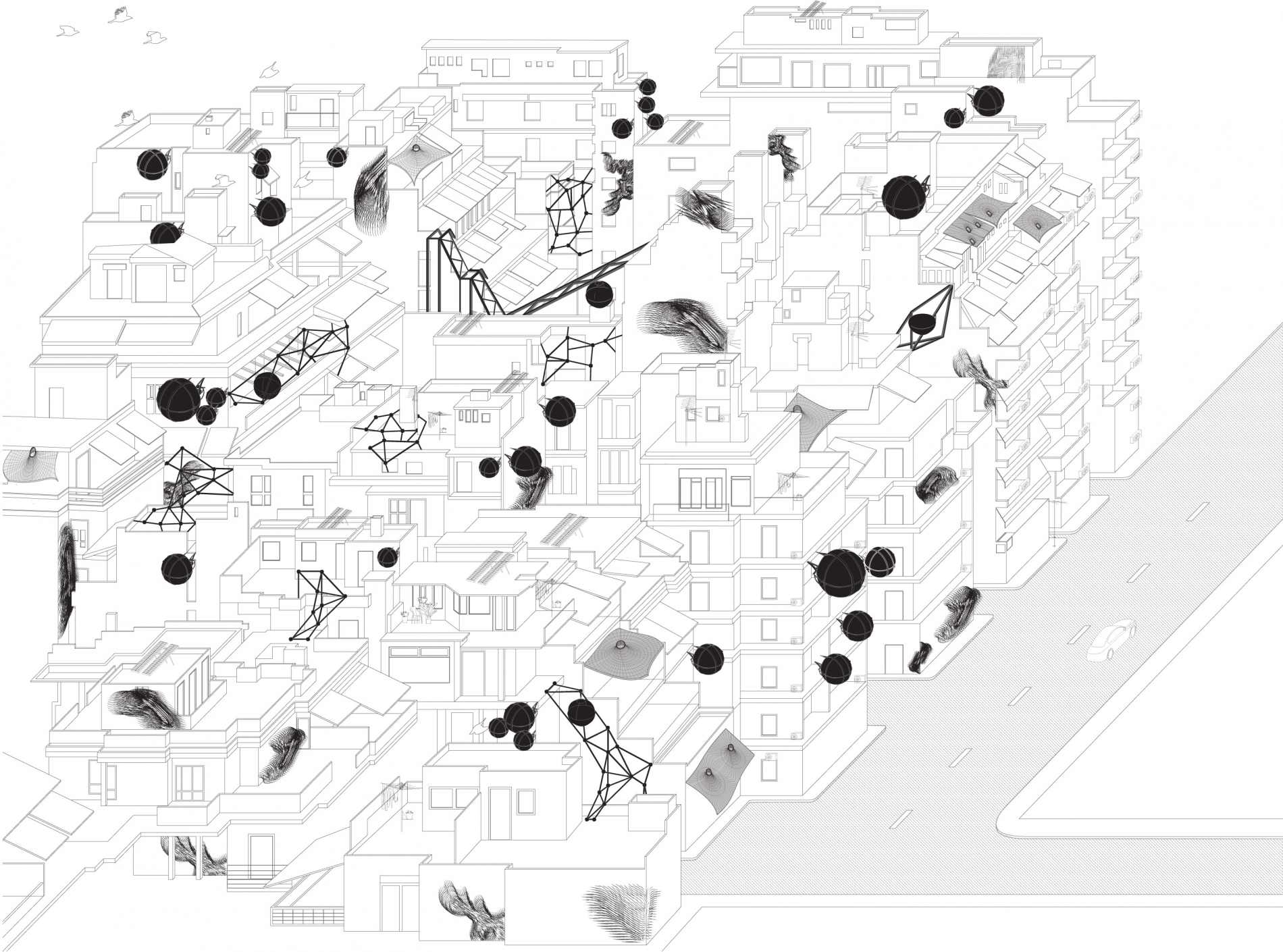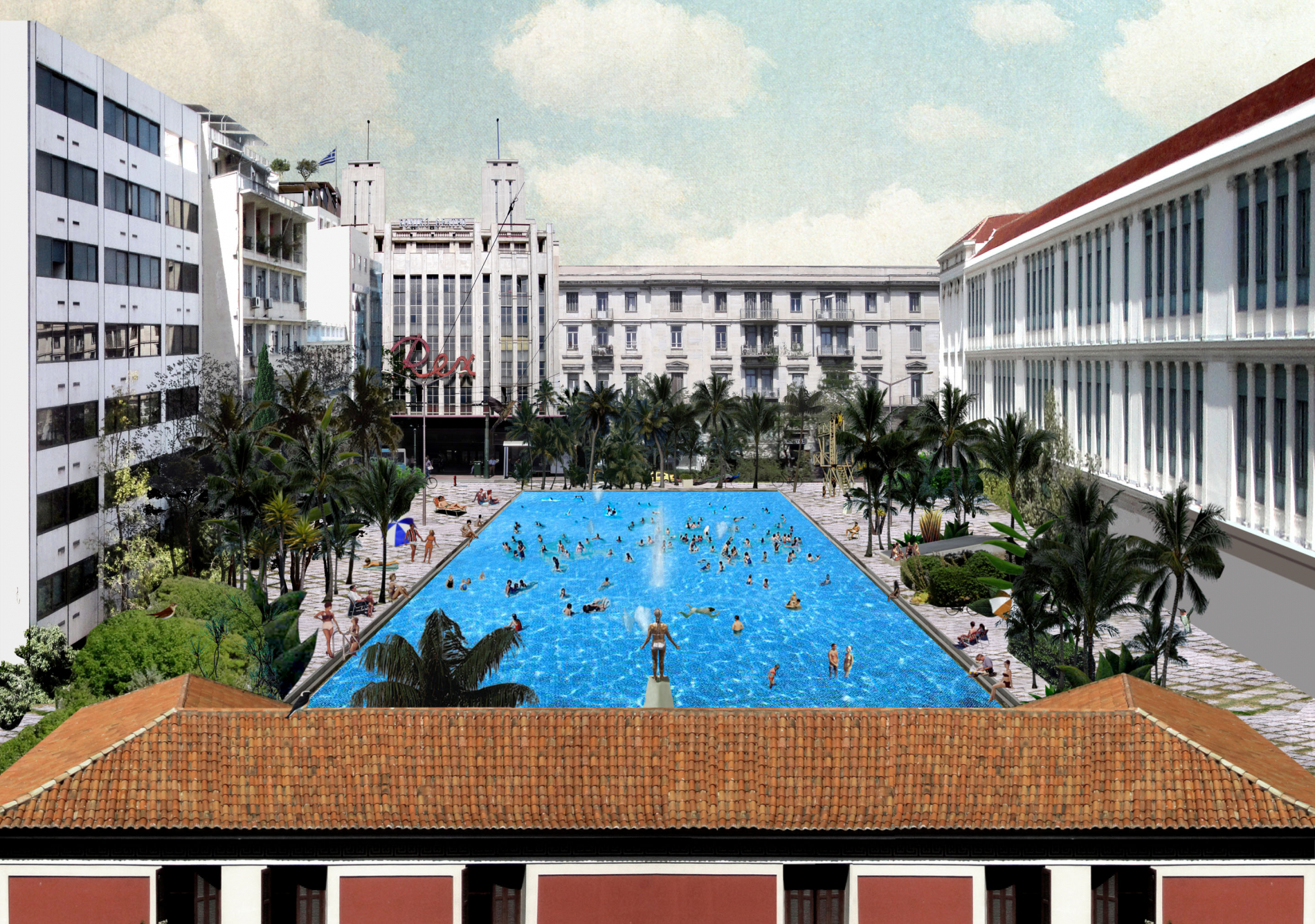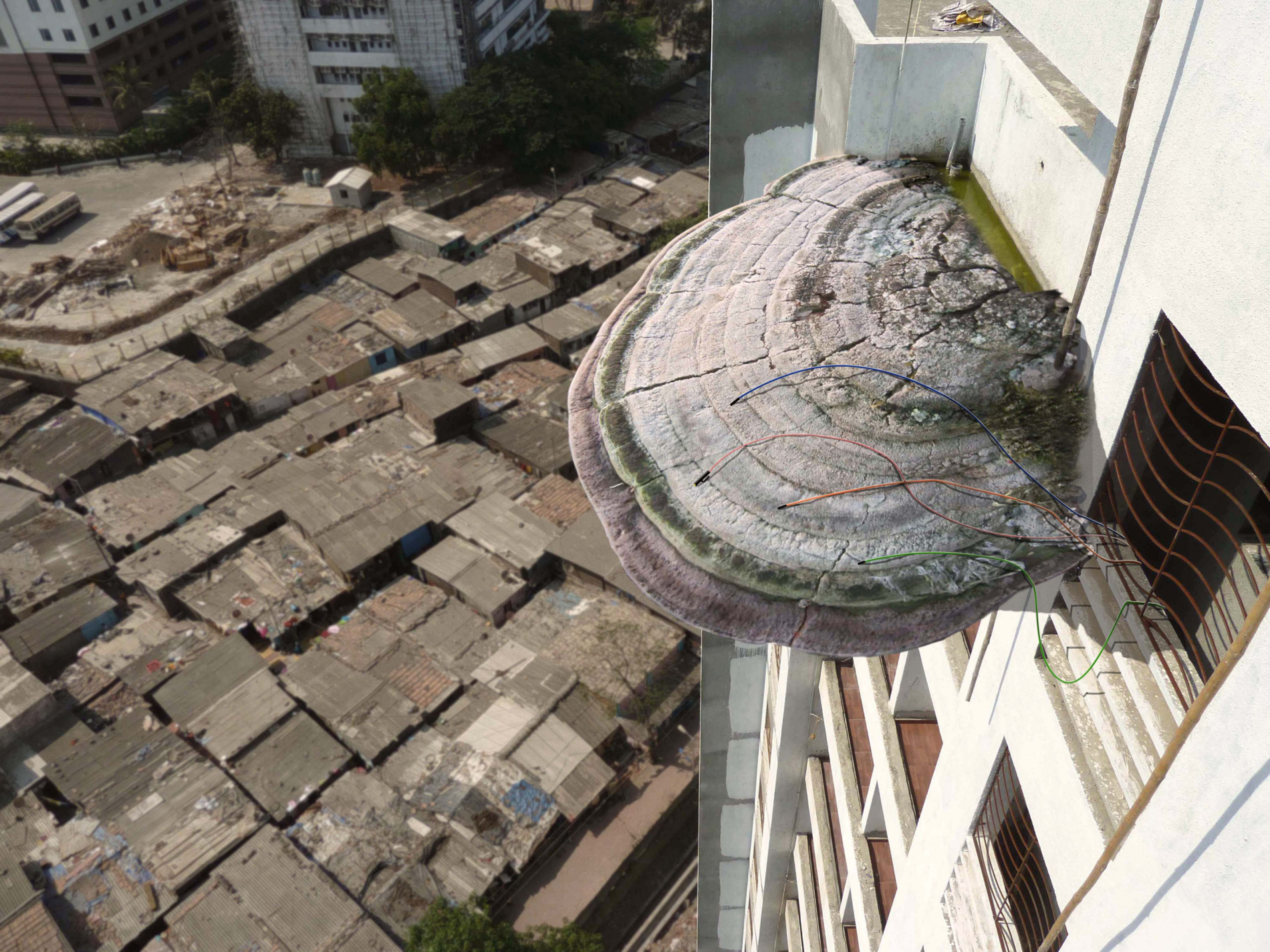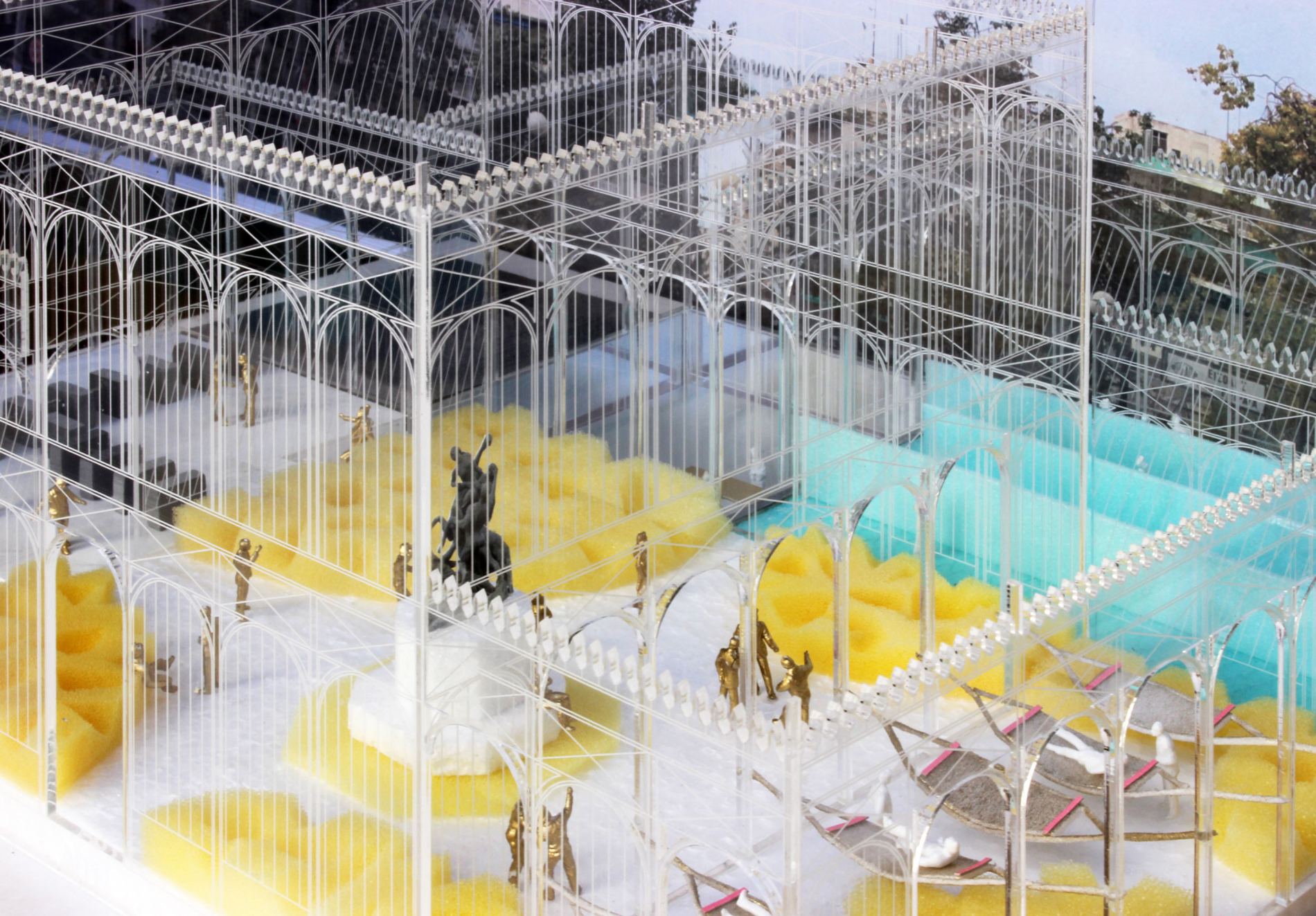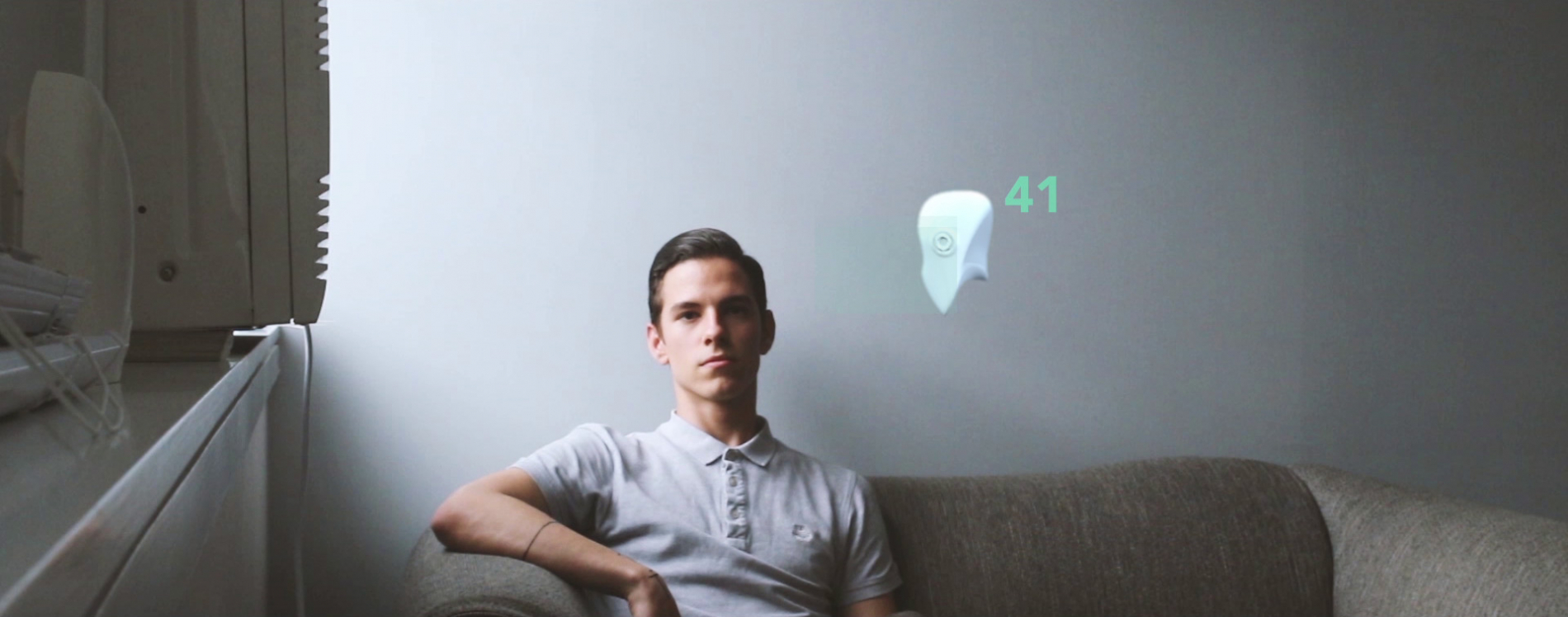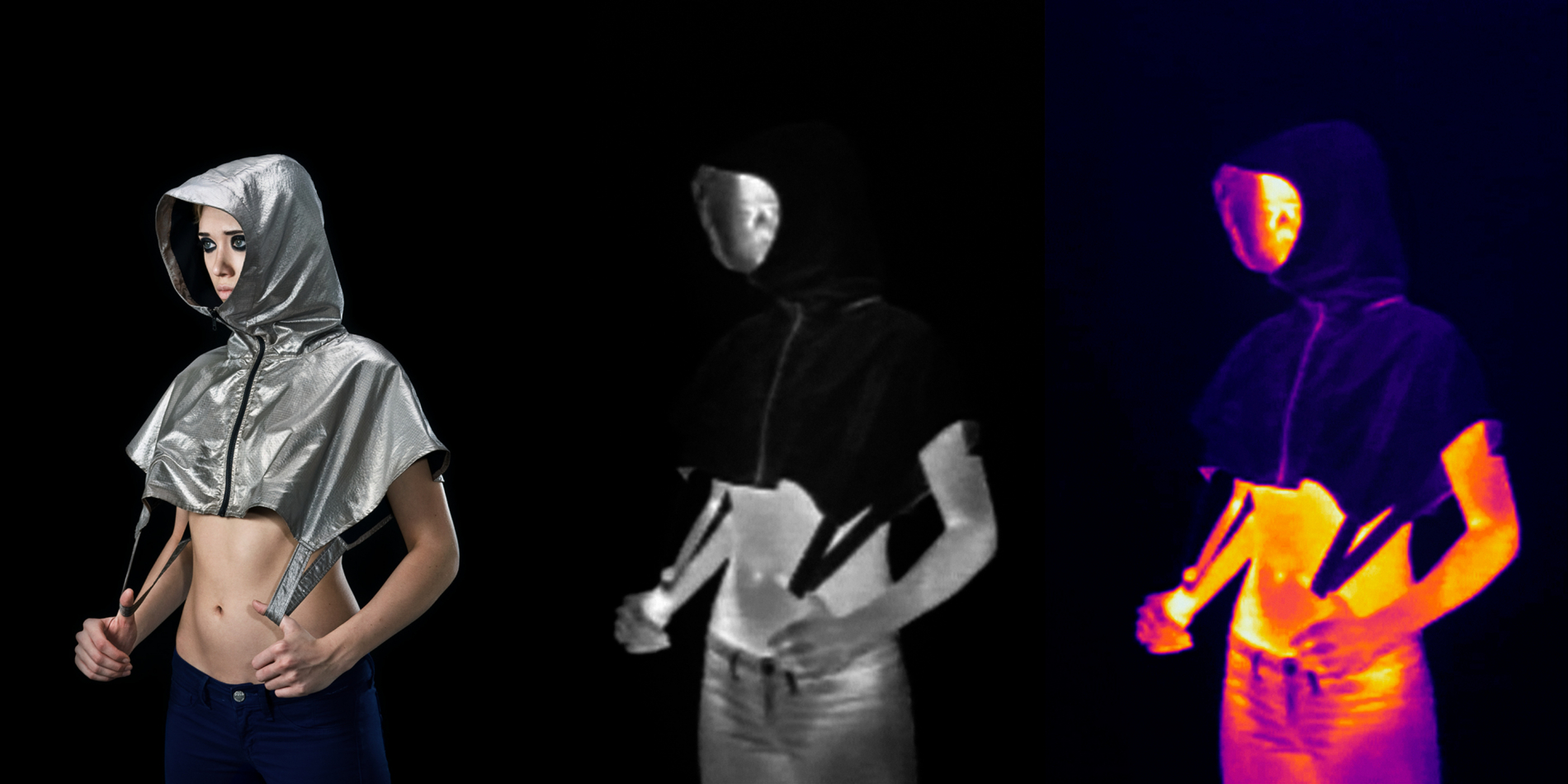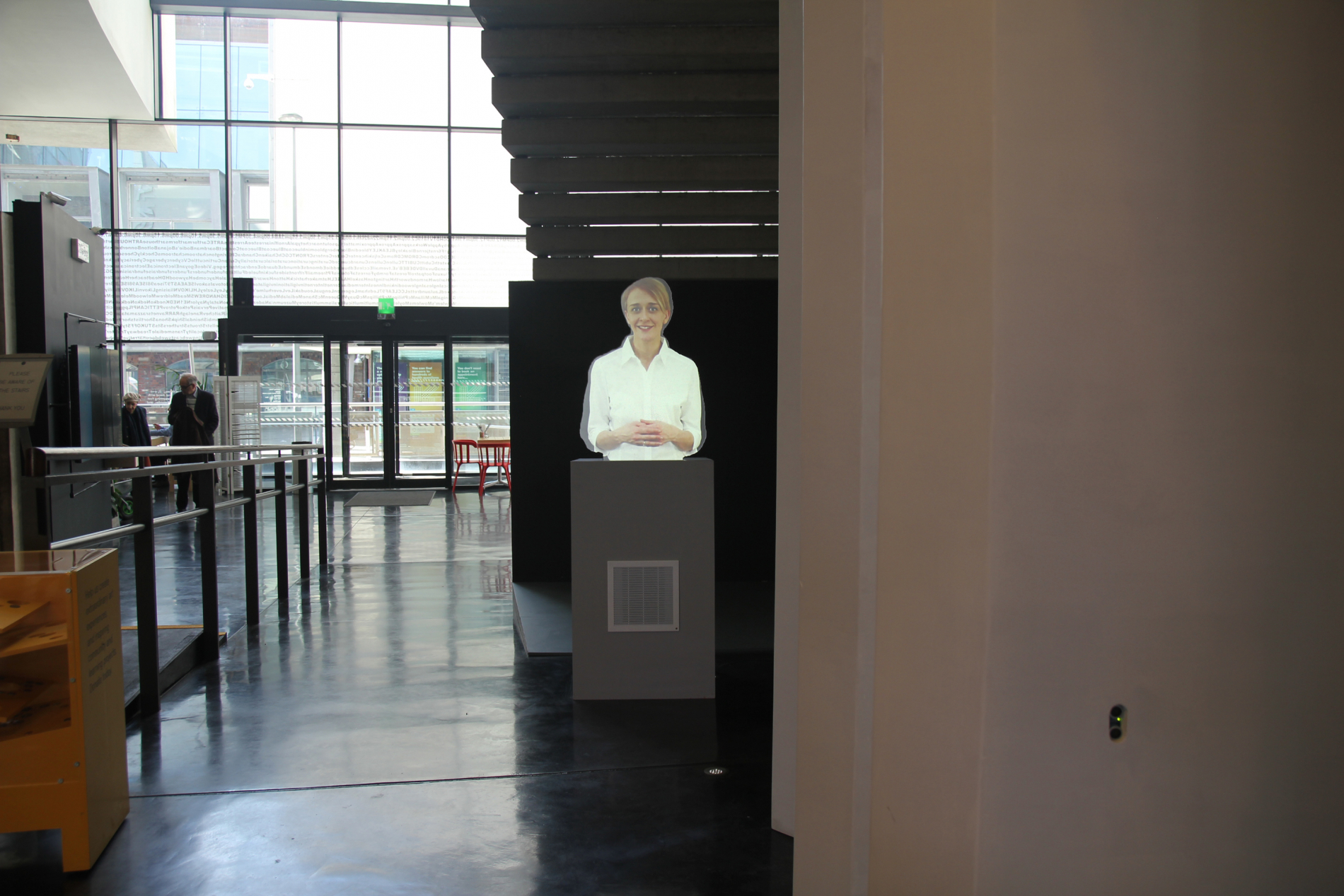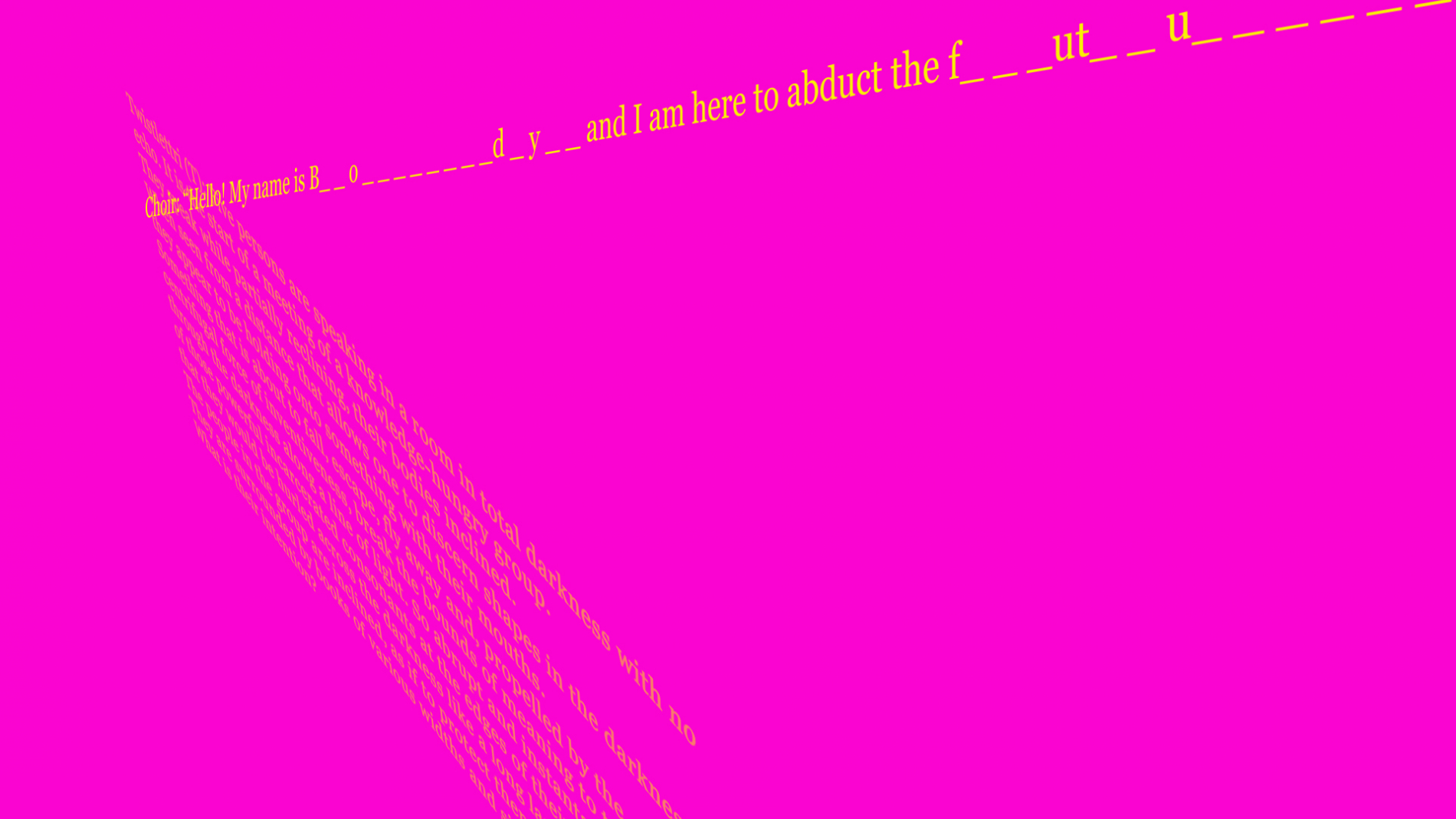
Algorithmic Society (20)
The ongoing economic crisis and the unemployment, the refugees’ issue and intolerance are all matters that current social structures have severe difficulties to face. Within this context, questions emerge about the sustainability of the contemporary cities, but also for the possible forms of organization that could prevail, or emerge. What happens when the limits of a society become more and more rigid? How will the anthropogeography of the cities evolve? Which role will the algorithmic systems and structures play?
The speculations presented as part of the exhibition balance between possible dystopias and utopias. Scenarios of increased surveillance, and stories of cities being abandoned, are complemented by hypotheses of unexpected alternatives. New forms of assemblage and cooperation are introduced as responses to the impasses of the contemporary world. New population groups appear as the ones that possibly can assist in the acknowledgement of heterogeneous identities, and in creating the conditions of co-existence and balance.
The theory of Ecumenopolis was developed by Constantinos Doxiadis' Athens Center of Ekistics as part of a research project for the “City of the Future” that was funded by the Ford Foundation.
According to Doxiadis, the great increase of urban population and the dynamic growth of cities will lead to their interconnection in a continuous network, into one universal city which we may call the ecumenic city, or Ecumenopolis. This is an inevitable reality that is already under construction and is likely to start acquiring shape at the beginning of the 22nd century. The big question that arises for Doxiadis is not about the dimensions, the structure, and the form of Ecumenopolis, but about its function, the type of life that will be created within it, and the quality of life that will offer to the people.
Doxiadis anticipates that the cities of the future will be extra-human, beyond human's capacity to control them. The world may be led to inhuman conditions as the problems and weaknesses of the 20th century's cities are multiplied. At the same time, he believes that Ecumenopolis may be “the real city of human” as for the first time in history, people will have one city rather than many cities belonging to different national, racial, religious, or local groups. Ecumenopolis will form a continuous, differentiated, but also unified texture consisting of many cells, the human communities. According to Doxiadis, this evolution corresponds to the dream of a cosmopolis, as the ideal state in which all people will be equal and united into one world.
The exhibition includes drawings, diagrams and photographs from the research project for the "City of the Future" where the theory of Ecumenopolis was developed, from lectures and publications by C.A. Doxiadis on the theory of Ekistics, and from the Delos Symposia that Doxiadis organized from 1963 to 1975. All material belongs to the Constantinos A. Doxiadis Archives.
© Constantinos and Emma Doxiadis Foundation
The Mediterranean Sea, in the sidelined European South, has been the stage of major tensions and urgencies due to its geographical particularity and cultural diversity: climate change, population movements, financial crisis, military and political conflicts, tourist exploitation. Part of the Mediterranean Sea, the Aegean archipelago connects but also divides two continents being therefore of crucial importance for many centuries in this area. Having opposed numerous gentrification attempts and investment plans during the last decades, the archipelago is found to accommodate in the future a decentralized network of small, fully sustainable, climate-controlled data centers, constructed on the islands or floating on the water, which enables people to safely and privately store and share their digital information and memory without relying on any kind of corporate cloud. This network of data centers managed by the islanders brings into form a kind of local traditional platform cooperativism. The islanders’ community consists of people who abandoned the urban centers of Europe, former refugees and indigenous islanders. In the face of the harsh and erratic regional conditions, the Aegean Datahaven connects the islands with each other creating new topologies and questioning at the same time the established forms of sovereignty, identity, geography and power. An extended archive of the data centers can be found in the Aegean Datahaven collection. The data centers are depicted on a series of drawings by an unknown traveler.
16.05.2117, 20:20
...spearmint, fennel, thyme, oregano – check
...grapes, peaches, cherries, melons – check
...olives, sesame, figs – check
...wheat, barley, almonds, walnuts – check
collecting, sorting, drying, depositing, freezing, sealing, exchanging – transactions completed
16.05.2017, 20:20
The spectator stoops slowly, inserts themselves in the inspection hole, observes the silos-displays, surveils the activities of community workers, experiences the architecture, is being lost in space.
Silo(e)scapes envisions a hybrid of a seed bank, a sharing economy and a museum for Mediterranean plant species that may disappear. In Silo(e)scapes techno-utopia, the threatened native seeds are stored in transparent silos/museum displays which are also the columns of a communal architecture. Silo(e)scapes provides to community workers the preservation of local seeds biodiversity and the protection of Mediterranean tastes, flavors, nutrients, and medicinal capacities threatened by environmental catastrophes as well as the increasing demand for control and standardization. Silo(e)scapes does not belong to private corporations. The members of Silo(e)scapes share the contents of the deposits. Autarky is a priority. And so is freedom and security.
Is the future of Mediterranean food a ruined landscape? Silo(e)scapes art installation transforms the anxiety of such dystopia into the experience of a futuristic architecture. In Silo(e)scapes spectators surveil a doll-house metaphor of a futuristic microcosmos through a panopticon structure that expands in infinity. Silo(e)scapes functions as a wearable room, a portal between reality and fantasy: Spectators insert their head into a hole to observe the threatened species, the seed bank museum, and the sharing economy of Lilliputian citizens. The seed-columns of the infinite space, the kaleidoscope of mirrors and agrarian sounds construct a perceptible space, which is neither real, nor a replica; it is rather artificial and illusive. Silo(e)scapes is both threatening and seductive. The theatrical and voyeuristic experience of Silo(e)scapes forms an apparatus that awakens memories, but also empowers spectators to disrupt the sequence of events causing the disappearance of these species.
Constant’s New Babylon (1959-1974) was a proposal for a city of the future where work would be automated and citizens would engage only with creative activities, based on their disposal, interests, and desires. With more time allowed for joyful encounters and emotional ties, a new urban economy would emerge. Fueled with intense creativity, this new economy and society would be able to utterly change everyday life. And it could. But, visions of the future sometimes are realised in the most controversial ways. Metahaven’s City Rising takes New Babylon as a starting point, and tells the story anew, from a contemporary perspective. It underlines how in times of crisis, a point has been reached that all and nothing is work. All and nothing, therefore, becomes driven by and from love, which is at once honest, barren, and capitalised. In City Rising, different forms and aspects of affective labour are tackled, while we are being invited to think about our bond with this condition, and its promises and compromises.
Electronic Urbanism is a research project in progress for more than 20 years. The first research stage starts during Zenetos' studies in Paris and concludes with the first presentation of the project at the Modern Housing Organization's exhibition in Athens in 1962. The final project for the "City and the house of the future" is presented at the 1st Building Exhibition at Zappeion in 1971. In this project, Zenetos has adapted his design for an all-purpose furniture that was distinguished in the Interdesign 2000 competition (1967).
Zenetos' project for the city of the future is the outcome of systematic research on the development of applications in electronics. Studying articles in scientific journals of the time, Zenetos defines accurately the forthcoming applications of 'tele-management', 'tele-work' and 'tele-services'. Taking into consideration the accelerating changes of living elements in the cities of the future, he proposed flexible systems for both building and infrastructures. He believed that the structure of the city and the house of tomorrow would have to be ephemeral and, as much as possible, immaterial. For this reason, he designed a system of light three-dimensional supporting cable-structures, like a spider's web, containing vertical garden-cities and dense networks of improved telecommunications media. The ground, which was left almost free, was an uninterrupted natural space as the city would expand over forests, lakes, rivers, and seas.
This space structure can receive any type of infill elements, but the most important one is that of the moveable tele-processing cell. The cell is equipped with ananthropomorphic all-purpose furniture, which controls the tele-activities, the audiovisual contacts, and the environmental conditions. According to Zenetos, this control switch is going to be the heart of the human of tomorrow. The adjustment of the furniture's various parts is mechanical through keys, but Zenetos already forecasts that in the future this will be controlled directly by the user's brain, with the help of a hyper-sensitive electro-brain waves receiver.
The material that is presented in the exhibition belongs to the Takis Ch. Zenetos archive.
α2525, Athens in S.F. is based on 13 short stories written by 10 Greek sci-fi authors, who were specifically commissioned to provide them imagining the future of Athens. It is a film project that was subsequently created to address the questions, images and ideas presented in the utopian or dystopian scenarios of the authors. In the form of an omnibus documentary, which makes use of interviews, videos and drawings, the film evokes the writers' visions and hypotheses regarding the city's future in different time periods. The project touches upon several issues such as: climate change; possible epidemics; the application of augmented reality in public space; the fusion of cities through virtual reality; the uncontrollable dissemination of fake news; religious fanaticism; a future society based on collectivity; a new autocratic plan of global development; technologies that are beyond man's control or trigger global geopolitical shifts. The film is accompanied by the published stories on which it is based.
Cinematic Essays of Urban Futures brings together nine short films that take as their subject matter the future of architectural form and the city, what architectural designer and theorist Penelope Haralambidou has called architectural essay films. Originally coined by the German artist and filmmaker Hans Richter, the term 'essay film' describes an intimate, allusive and idiosyncratic cinematic genre at the margins between fiction and documentary. Although under-theorised, the essay film has a long history as a form that thinks and thought that forms, as French film essayist Jean-Luc Godard asserts. Combining digital filmmaking with architectural proposition, the cinematic musings on show bridge theory with practice and design with commentary. By introducing empathy and the dimension of time the films can unlock the storytelling, political and philosophical subconscious of the global city of tomorrow and grasp alternative near-future scenarios.
The films are produced by students in March Unit 24 at the Bartlett School of Architecture, UCL. It is a research laboratory making the most out of recent advancements in digital technology that have brought the disciplines of film and architecture closer than ever before.
Selected by Penelope Haralambidou, the films are organised in three sub-categories:
Tomorrow’s cities: Finbar Fallon, Subterranean Singapore, 2016; Kairo Baden-Powell, Fictional Constructs, 2014; Azizul Hoque, Whalemart City, 2016.
Tomorrow’s buildings: Brook TJ Lin, An Anatomical Embassy, 2016; Angeliki Vasileiou, Weaving the Ineffable 2015; Emir Tigrel, Vestigial Landscapes, 2015.
Tomorrow’s landscapes: Nico Czyz, The Long Now Foundation, 2016; Stefanos Levidis, The Embassy of the Displaced, 2016; Ed Mascarenhas, Barbecana, 2014.
In Tomorrow’s Storeys we drift from room to room, eavesdropping in on the overheard conversations of the occupants of a near future Athenian apartment block. Beginning two months prior to the opening of the Tomorrows exhibition architect Liam Young organised a public think tank consisting of a group of science fiction authors, visual artists, directors, photographers and architects, aiming to produce a series of critical fictions about the future of Athens. Through discussions, illustrations and speculations, the working group authored a series of short stories set within the walls of a single imaginary apartment block, collectively constructing narratives of the future life of Athenian citizens. Evolved from the traditional form of the Polykatoikia, the building they designed is a continuous urban mass where each Athenian is not given a minimum basic income but rather a minimum basic floor area, a percentage of the volume of a building but not a fixed location. The block is a portrayal of a new form of urban organisation where a building is reformatted like a Facebook page and a diverse group of occupants are collapsed together in radical juxtapositions as they roam across the floors, following functions that are shifting by the hour. This is just one temporary moment in a block of endless configurations, a window into a speculative building, the city that surrounds it and the lives it contains.
Air Shake examines the character of air pollutants in Athens of the year 2027 to imagine both an array of future diseases and cures. It documents phenomena of leaching caused by a variety of chemicals that have been released into the atmosphere and their scientific, economic, and social attributes. Air Shake projects current urban habits in plausible future scenarios extracted from the present, based on the impact that different mixtures of air impose on human bodily systems. The project imagines an array of diseases that have begun to manifest in 2012, with Athens registering the highest levels of atmospheric pollution in decades. Because of the debt crisis and the citizens’ denial to yield to the overblown energy taxation, the continuous combustion of random cheap available materials, has resulted in the excessive release of particulate matter, sulfur dioxide, carbon monoxide, and other carcinogens, eventually disemboweling the livelihood of citizens and their right breathe in the city. The projection of four speculative diseases onto the urban environment takes form as a series of healing environments, making visible the linkage between the air pollution and the imagined disease. The Air Shake installation operates around two systems that together create an immersive experience. First, there is a series of chimneys, which present the city upside-down, spewing different shakes of air mixes to heal city dwellers. A secondary system is visualizing the air shakes each chimney spews in a virtual reality environment, accessible through a series of movable tablets installed in the room. The installation space is imagined as a virtual healing environment that allows the physical embodiment of the visitors to project and immerse themselves in a series of future atmospheres.
Considering the future of our cities, a real challenge is to reinvent the way that we are using them today. Especially in cultures with limited means, how could we improve and even transform the cities we have found ourselves living in, in banal, low tech, affordable and immediately realizable ways? Today, cities are often filled with unnoticed, left-over spaces between buildings, while what is typically called public space is no more than unimaginative, hard surface with nature as decoration.
High quality public space could be a critical tool to create compact, efficient and mixed-use cities where residents are close to nature and where urban life is celebrated. They can become magnets similar to monuments, giving identity and value to their surroundings. Inhabitants will be inspired to use the areas close to their homes more, replacing motorized transport with walking and biking, reducing pollution and gaining free time.
High quality public space can be achieved regardless of its size and type. Although rarely the case, it can be playful, fun and optimistic.
A Hothouse is a techno-natural apparatus providing a controlled, warm environment for cultivating plants. On the other hand, a Concentration Camp is a gated settlement for people excepted from law protection, usually under the condition of obligatory labour. Connecting the two terms and programs in a hybrid one, Hot_Camp is introduced as an apparatus for collective living and working in the margins or in-between cities. It intends to provide a spatial and performative condition under which metropolitan life melts into rural life and vice versa. Life for moving people in a state of emergency is challenged to form an open community. The assemblage of people with controversial identities reflects in an architectural assemblage of various living spaces, objects and organic apparatuses. All these form an alternative urban block, generic, awaiting to be grounded anywhere, as a colony between the city and the land. This trans-urban block refers to the precarious conditions of tomorrows’ life, in relevance to the South, under the Mediterranean climatic, anthropological and political horizon.
During the Indian Civil War, the Dharavi slums of Mumbai were flooded with refugees looking to escape the conflict. The Mumbai authorities, distracted by defense of the city and facing an already over-populated and poverty stricken slum could do little to maintain a semblance of civilised life in the area. Sometime later a cache of biological samples appeared through the criminal networks of Mumbai, in the vain hope that it might provide new marketable narcotic opportunities. The collective drive and expertise of the refugees managed to turn these genetically-engineered fungal samples into a new type of infrastructure providing heat, light and building material for the refugees. Dharavi rapidly evolved its own micro-economy based around the mushrooms. This documentary tells the story of some of the characters involved from Mumbai and the rest of the world and how Dharavi came to be such a unique place.
In the summer of 2015, refugees from the Middle East found temporary shelter at Victoria Square, on their journey to Western Europe. Since then, Victoria, an urban space of bourgeois past and imperial name, has become a nexus of the refugee crisis, with an extended solidarity network providing shelter and guidance.
Victoria: Way In/Way Out imagines the space of Victoria Square as a paradigm for the future of the Mediterranean city. Two parallel urban entities coexist: the ‘Shelter’ and the ‘Transparent State.’ The first emerges within the concrete frames of former polykatoikies, i.e. apartment blocks, that now function as small, live-in ‘factories,’ where a diverse population of urban dwellers engages in the low-tech production and exchange of knowledge, products and services of a post-capitalist society. As an ever-changing, horizontal city perpetually linked to the present, the ‘Shelter ’ is intersected by the ‘Transparent State’: a formal and invariable network of radically privatized infrastructures and public spaces, with restricted access and limited rights, where constant surveillance guarantees safety and conformity to the past.
Victoria Square itself has been transformed into a new Crystal Palace, or ‘Embassy,’ negotiating between the ‘Shelter’ and the ‘Transparent State.’ Mobility and the transitory nature of human occupation are everywhere on display, mediated by control points, waiting rooms and prepared experiences, whereby individuals may or may not be granted further access.
The 1950’s television series The Twilight Zone was a series focusing on the cross over between humanity’s fear, intelligence and superstition. In the original series, an episode called “The Lonely” focused on a man sent to prison on asteroid for solitary confinement but falls in love with a woman like robot who becomes his companion. In that time, our fears were catalysed through magic or science fiction, but our fears now lie in the unprecedented growth of technology. With our smartphones becoming a deposit of our life, our friend, what will this relationship be in 50 years? Speculative design can help us extrapolate our current beliefs onto to tomorrow’s technology. During a schooling semester, students were asked to design objects over the next three generations. The overwhelming majority focused on companionship, a friend from birth till death. With our fears and superstitions turned up to a deafening volume we can speculatively assess what future designers of technology companionship should consider. The works present students’ different fears and excitements over the future of technological friendship, consulting complex realm of ethics, reality and logic. Some are optimistic, some are not but upon meta-analysis of all the students' views it becomes apparent that the future of technological companionship is under negotiation.
3D printed objects sponsored by Stratasys Ltd. using J750 full-colour multi-material printing technology.
Featuring the following projects:
Play, Protect, Preserve, by Nicole Hone
Bot, by Evangeline Martin
Postcards from Mars, by Loek Hendriks
Stealth Wear is a vision for fashion that addresses the rise of surveillance, the power of those who surveil, and the growing need to exert more control over privacy. It explores the aesthetics of privacy and the potential for fashion to challenge authoritarian surveillance technologies. The project is a collection of metal-plated garments that evade the thermal cameras used on military drones. The collection is inspired by traditional Islamic dress and the idea that garments can provide a separation between man and God. In Stealth Wear, this idea is reimagined in the context of drone warfare as garments that provide a separation between man and Drone. The 'anti-drone' burqa, hijab, and hoodie are fabricated with a highly-flexible silver-plated fabric that reflects the wearer's thermal radiation. This fabric can prevent observation for overhead thermal imaging systems, such as those used by military drones and heat-seeking munitions.
We largely conflate technology with speed, imagining near futures that are dystopian and accelerated, efficient and lifeless. Technology is exclusively considered fast, dynamic, frenetic. The future is closer than it may appear--maybe just an invention away. It moves at the speed of a signal, transforms instantly, and displaces generations in ever-shorter cycles. But technology can move as slow as it does fast. What if we considered how it might resistprogress, counter efficiency and derail optimization?
Man fears time; time fears the pyramids, warns a 12th century Arab proverb. We understand the pyramid as the most enduring form of resistance: weathering the storms of humanity and cultural change. Pyramids allure us with myth, with scale, and with the impossibility of their construction. They seduce us with their platonic clarity, elemental materiality and ambiguous use. They withstand. They are a bit ridiculous.
For Tomorrows, the New Affiliates have produced a pyramid generator: a black box process that samples from the digital universe to produce new kinds of pyramids every four minutes. Whatever is plugged into the generator will read the pyramids: bring a printer, and you’ll soon find a stack of postcards; plug in your phone, and they’ll pop up on screen; attach a speaker and you’ll hear them described. Yet no matter your engagement, no matter the state of technological progress, and no matter time, the generator will continue forever; producing an infinite set of relations, networks and data all reduced to a platonic that only knows to resist.
Homo Sacer is an installation consisting of a projected 'hologram,' of the kind increasingly found in airports, railway stations and government buildings. The hologram speaks lines from UK, EU and UN legislation, as well as quotations from government ministers, regarding the nature of citizenship in the 21st century. Beginning with the Universal Declaration of Human Rights' 1948 directive "Everyone has the right to a nationality," the hologram's monologue steps through the various laws which repeal this right, culminating in the text of the letter which stripped young Mohamed Sakr–who was later killedby a drone strike–of his British citizenship, and the UK's Home Offices oft-repeated mantra "Citizenship is a privilege not a right." Homo Sacer walks visitors through the process by which a citizen can be translated through various forms of identity, and ultimately reduced to the state of homo sacer, the accursed man, who may be killed at any time.
Hello! My name is B_ _ o _ _ _ _ _ _ _ _d _ y _ _ and I am here to abduct thef_ _ _ut_ _ u_ _ _ _ _ _ re_ _ _ is a polyphonic–both real and fictitious–discussion between five persons and one Alien-Narrator. The project poses as its starting point the question of the relation between the body, gender, language and the future. More specifically, it explores the political dimension of trans* /inter*/ non binary /de-gendered identities and their relation to language and their visions about the future.
The discussion begins with following assumptions and inquiries:
We cannot speak about the future without first speaking about gender. And we cannot speak about gender without modifying the language in which we speak and feel and understand and love one another. The future–if something like this exists–passes necessarily through the de/re- construction of language. Language becomes not just the means but the body itself. How is this possible? Is a gender transition possible only through language?
The project proposes to design a new language of the future for the trans*/inter*/ non-binary / de-gendered body. For the body who wants to construct /form a new identity. Or even a language for the erasure of identity.
Ashley Madison Angels at Work in Athens is part of a series of works researching Ashley Madison, a Canadian online dating service marketed worldwide to married people seeking casual sex. In July and August 2015, an anonymous group called The Impact Team stole and released all of Ashley Madison's internal data–including the entire website code and functionality, customer data and the CEO's emails. The data breach revealed that with a disproportionate number of male subscribers and virtually no human women on the site Ashley Madison had created an army of 75,000 female chatbots to draw the 32 million male users into (costly) conversations. This triggered !Mediengruppe Bitnik to use Ashley Madison as a case study to raise questions around the current relationship between human and machine, Internet intimacy and the use of virtual platforms to disrupt the physical.
For Tomorrows, !Mediengruppe Bitnik uses the localized data from the Ashley Madison hack to give atemporary physical embodiment to 7 of the 165 fembots that were active in Athens at the time of the data breach. Each fembot has a name, an age and a location and uses sentences from a list of pick-up lines to contact other users. The 165 fembots of Athens provided entertainment to around 22.910 registered users in Athens.
What if political governance were replaced by one speaking kitten AI?
The year is 2039. After years of political turmoil catalysed by R-Crisis EMEA, a refugee crisis triggered by war and the detrimental effects of climate change, the incompetence of the political elites to generate and retain trust in the populations becomes ever more obvious. Politicians across Europe and EMEA countries fail to serve the sentient human.
One pioneering neuro-engineer develops an artificially intelligent and–for the first time–feeling virtual being. Kitty AIis an artificial intelligence with the affective capacities of a cat who can love up to 3 million people. The AI not only carries the tasks of a governor; it also takes care of its citizens at a personal level. It takes care of garbage disposal, makes sure your children get to school safely and drink clean water. She/he/it manages the citie's household budget, and maintains diplomatic relations with both physical and virtual leaders of the world.
This speculative future scenario is inspired by the Black Mirror episode "TheWaldo Moment,” where a cartoon character becomes a presidential candidate, an idea that seems less absurd considering the political developments of 2016/2017. German author Leif Randt’s novel Planet Magnon enfolds a narrative in which computers run an entire galaxy, a concept that is supported by the emerging field of Global Systems Science.


